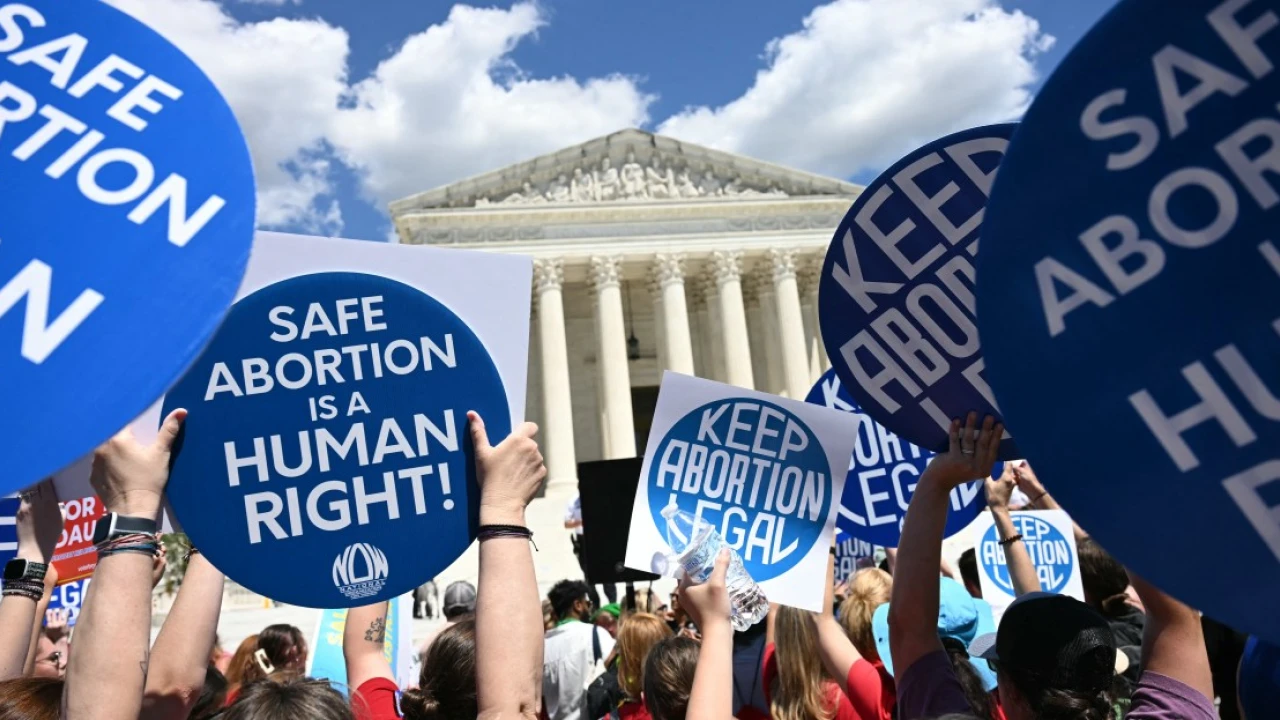Regional
The Supreme Court’s newly leaked abortion decision, explained
For the second time in two years, a major Supreme Court abortion decision leaked before the justices officially released it. This time, however, the most likely explanation is a clerical error by someone who manages the Court’s website. Two years ago, an earl…

Editor’s note, June 27, 11:30 am ET: The Supreme Court officially released its opinion in Moyle v. United States on Thursday morning. It reaches the same result as the leaked draft. For the second time in two years, a major Supreme Court abortion decision leaked before the justices officially released it. This time, however, the most likely explanation is a clerical error by someone who manages the Court’s website. Two years ago, an early draft of Justice Samuel Alito’s opinion in Dobbs v. Jackson Women’s Health Organization, the case overruling Roe v. Wade, leaked to the press. The identity of the leaker remains unknown, as does the leaker’s motive. About two months after the leak, the Supreme Court released its final opinion in Dobbs, which was substantially similar to the leaked draft. On Wednesday, another significant abortion opinion leaked — although this time the leak appears to be an accident. According to Bloomberg, the justices’ opinions in Moyle v. United States were “briefly posted on the court’s website” before being taken down. A Supreme Court spokesperson said that “the court’s publications unit inadvertently and briefly uploaded a document to the court’s website,” and that the final decision will be “issued in due course.” Bloomberg posted the text of the leaked document at this link. Moyle asks whether states can ignore a federal law which requires most hospitals to provide emergency care to patients who need it — including abortions if that is the appropriate medical treatment. Specifically, whether Idaho’s near-total ban on abortions prevents doctors from providing medically necessary abortions. Assuming that the leaked document resembles the Court’s final decision, a majority of the justices have decided not to decide the Moyle case. Though the Court has seemingly splintered into four separate concurring and dissenting opinions, none of which garnered a majority of the justices’ support, five justices apparently decided that the Court was wrong to take up this case using an expedited process that bypassed an intermediate appeals court. The leaked document does contain some good news for abortion rights advocates. Last January, the Court temporarily blocked a lower court decision, which held that the state of Idaho cannot enforce its strict abortion ban against patients who need an abortion to save their life or to ward off catastrophic health consequences. In the leaked document, six justices voted to reinstate the lower court’s order — at least for now — which means that Idaho patients who require medically necessary abortions will no longer need to be airlifted to other states. Still, the primary effect of the decision, assuming it closely resembles the leaked draft, will likely be to punt the final resolution of this case until after the election. That means that patients outside of Idaho — who may have been hoping a decision in this case would set a precedent requiring ER doctors across the country to follow the federal law requiring care in the event of an emergency — may not be able to obtain abortion care that they need to save their life or to ward off very serious health consequences. What’s at stake in Moyle The federal Emergency Medical Treatment and Labor Act (EMTALA) requires all hospitals that accept Medicare funds — which is nearly all hospitals — to provide “such treatment as may be required to stabilize the medical condition” of “any individual” who arrives at the hospital’s ER with an “emergency medical condition.” EMTALA, moreover, defines an “emergency medical condition” to include not just conditions that threaten a patient’s life, but also conditions that risk “serious impairment to bodily functions,” or “serious dysfunction of any bodily organ or part,” among other things. Thus, if a patient’s uterus would be destroyed if they do not receive an abortion, EMTALA generally requires hospitals to provide that abortion even if the patient is likely to survive without it. This federal law conflicts with an Idaho statute, which bans all abortions except when “necessary to prevent the death of the pregnant woman.” When a federal law conflicts with a state law, the Constitution provides that the federal law “shall be the supreme Law of the Land” — and thus the state law is “preempted.” EMTALA also contains a provision stating that state and local laws must give way “to the extent that the [state law] directly conflicts with a requirement of this section.” So this should be an easy case. EMTALA imposes a broad requirement on nearly all hospitals to provide emergency care, and it does not include an exception for abortions. The statute, moreover, explicitly says that state laws must give way when they directly conflict with EMTALA. But, in this Court, nothing involving abortion can ever be easy. How Moyle seems to have divided the justices The Court’s three Democratic appointees, Justices Sonia Sotomayor, Elena Kagan, and Ketanji Brown Jackson, all argue in two separate leaked opinions that EMTALA means what it actually says — though they appear to have split on a procedural question. Ordinarily, the Supreme Court waits until at least one appeals court has weighed in on a case before taking it up. In Moyle, however, the Court invoked an unusual process known as “certiorari before judgment” to bypass the appeals court that was supposed to hear this case. Kagan, joined by Sotomayor, argues that the case should be sent back to the appeals court that should have heard Moyle in the first place. Jackson, meanwhile, argues that the Court should rule immediately that EMTALA means what it says. As she writes in the documents Bloomberg published, doctors “observing the different legal thresholds for action under state and federal law” will “surely be cowed into not providing abortion” that is required by federal law — especially because of the risk that they could be prosecuted under state law. A decision by the Supreme Court holding that EMTALA trumps state law would allow doctors to perform medically necessary abortions with certainty. At the Court’s rightward extreme, Alito, in a leaked opinion joined in whole by Justice Clarence Thomas and in part by Justice Neil Gorsuch, argues for an abortion exception to the EMTALA statute. Alito primarily points to several provisions of the law which use the phrase “unborn child” (these provisions primarily require hospitals to offer stabilizing care to a pregnant patient’s fetus), suggesting that a statute which uses that phrase must not be read to permit abortions. Alito also makes a novel constitutional argument, claiming that the state of Idaho must consent before its abortion ban can be preempted by EMTALA. That leaves Justice Amy Coney Barrett, writing for herself, Chief Justice John Roberts, and Justice Brett Kavanaugh, in the middle. Barrett’s opinion, as it’s published in the Bloomberg leak, leaves nearly every important question raised by Moyle unresolved. She agrees with Kagan that the case should be sent back down to the lower court, thus creating a majority for that result. And she writes that Alito’s constitutional argument is “difficult and consequential” without taking a position on that argument. The thrust of Barrett’s opinion is that there is no longer a need to bypass the appeals court and decide this case on an expedited basis because of concessions made by lawyers on both sides. The Biden administration, which argues for EMTALA to be read according to its plain text, conceded that EMTALA could not be used to authorize abortions because a patient has a mental health condition. And it also conceded that federal laws permitting hospitals or doctors with moral objections to abortion to opt out of providing them still apply even under EMTALA. Idaho’s lawyers, meanwhile, claimed that its state law permits abortions for some medical conditions “even if the threat to the woman’s life is not imminent.” According to Barrett, the “parties’ positions are still evolving” in this case, and thus it makes sense for those positions to be refined in a lower court before the Supreme Court has the final word. So the good news for abortion rights supporters is that emergency room patients in Idaho will have the full benefit of EMTALA, at least while this case is working its way through the appeals court and back up to the justices. The bad news is that the leaked Moyle decision does nothing to help those same patients in the other 49 states. And that’s a serious problem for abortion rights generally. As Jackson notes in her opinion, one problem that’s emerged since Dobbs is that, while even the most anti-abortion states typically permit abortions in some cases — such as if the life or health of a patient is threatened — there are often no court precedents explaining when abortions are allowed and when they are not. That means that doctors cannot know, and their lawyers cannot advise them, on when it is legal to perform a medically necessary abortion. And that has created a reality where those exceptions are “exceptionally difficult — in some states, nigh impossible — to qualify for,” as my colleague Nicole Narea reported: > Kate Cox, a Texas woman, was notably denied an abortion even though her fetus was diagnosed with a rare and terminal genetic condition and forced to travel out of state to obtain one. Other women have been forced to carry to term fetuses doctors know will die shortly upon birth, or been denied abortion care even after experiencing a miscarriage that leaves them in medical distress. The Texas Supreme Court also ruled against a group of 20 women who claimed that they had been denied medically necessary abortions. The Moyle lawsuit was an effort to solve this problem by allowing federal courts to develop precedents stating when EMTALA creates a right to an abortion. But that process cannot begin until the courts agree that EMTALA means what it says. Thus, if the leaked Moyle decision proves to be authentic, that means it may be months or even years before the federal courts can start generating the precedents that hospital lawyers need to advise their clients — and that’s assuming that Alito doesn’t ultimately have the votes to write an abortion exception into EMTALA.
Continue Reading
-

 Regional 20 hours ago
Regional 20 hours agoMaryam grateful to people of Punjab for not supporting anarchists
-

 Pakistan 21 hours ago
Pakistan 21 hours agoList revealed of injured, deceased brought to hospital in PTI protest
-

 Regional 2 days ago
Regional 2 days agoSecretary Schools Punjab announces winter vacation dates
-

 Regional 2 days ago
Regional 2 days agoCouple's wedding photoshoot in front of containers in Islamabad goes viral
-

 Pakistan 16 hours ago
Pakistan 16 hours agoBelarusian President, PM Shehbaz arrive in Murree
-

 Sports 1 day ago
Sports 1 day ago2nd ODI: Zimbabwe set Pakistan target of 146 runs to win
-

 Business 1 day ago
Business 1 day agoPossibility of petrol shortage in twin cities, Lahore
-

 Pakistan 1 day ago
Pakistan 1 day agoPresident, Interior Minister condemn attack on Rangers
























